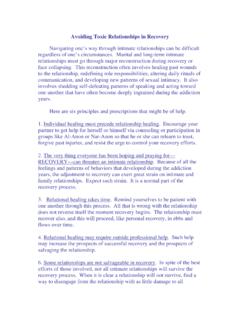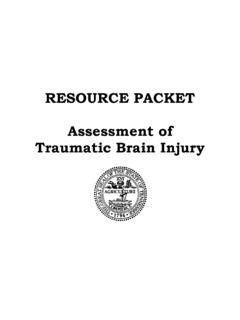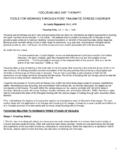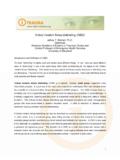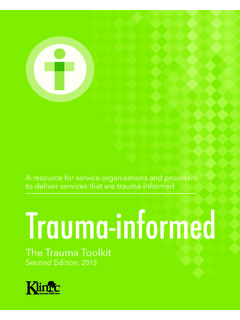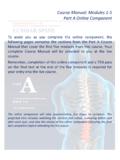Transcription of What is Your Recovery Quotient - William L. White
1 what is your Recovery Quotient ? Toward Recovery -focused Education of Addiction Professionals And Recovery Support Specialists William L. White (March 2012). The certification exams used to judge the competency of addiction professionals (from addiction counselors to physicians specializing in addiction medicine) rely almost exclusively on questions that test one's knowledge of the psychopharmacology of drugs, addiction and its related pathologies and the theories and methods of addiction counseling and treatment. Striking by their absence are questions about the stages, styles, pathways and processes of long-term Recovery and the history and philosophies of American communities of Recovery . The following questions were developed in an afternoon of musing about the Recovery Quotient of addiction professionals and what an exam would look like that tested knowledge related to the history, theory, science and practice of non-clinical Recovery support.
2 There is nothing magical about these particular questions; I suspect on another afternoon I might come up with a quite different list of questions. But the questions included will sensitize the reader to the central point of this exercise: there is a body of knowledge about Recovery that is quite distinct from the bodies of knowledge about addiction and addiction treatment. The intent of this little quiz is to stimulate interest in the lived solutions to the problems many of us have devoted our lives to addressing. So take a few moments and evaluate your Recovery Quotient . Most of the topics imbedded in these questions are discussed in the papers posted at , in my book Slaying the Dragon: The History of Addiction Treatment and Recovery in America, and in my recent monograph Peer-based Recovery Support: History, Theory, Science and Practice. I. True or False (6 points).
3 Place a T or F before each statement based on whether the statement is true or false. ___ 1. Smart Recovery grew out of a schism within Secular Organization for Sobriety. ___ 2. Methadone Anonymous is a Recovery mutual aid society dedicated to helping people recover from methadone addiction. ____ 3. Between 1970 and 2010, the percentage of people working in addiction treatment who are in Recovery has dropped precipitously--from nearly 70% to about 30% of the treatment workforce. ____ 4. The creation of Faces and Voices of Recovery grew out of the 2001 National Recovery Summit held in St Paul, MN. ____ 5. Faces and Voices of Recovery includes all Recovery constituency groups except individuals and groups representing people in Recovery from opioid addiction who are being treated with methadone. ____ 6. Nearly a third of MM members later choose abstinence-based Recovery .
4 II. Multiple Choice Questions (25 points). Answer each of the questions below by selecting the correct answer from the four choices presented. ___1. The earliest peer-led alcoholism Recovery support effort in the United States from the list below is: a. The Washingtonians b. Alcoholics Anonymous c. The Handsome Lake Movement d. The Drunkards Club ___2. The first Recovery mutual aid society birthed within an addiction treatment program was: a. The Hazelden Alumni Association b. The Ribbon Reform Clubs c. The Keeley Leagues d. The Ollapod Club ___3. Which of the following Recovery mutual aid groups uses admission of addiction . as a catalytic step in the Recovery process? a. Alcoholics Anonymous b. Narcotics Anonymous c. Cocaine Anonymous d. Women for Sobriety ___ 4. The first President of the United States whose National Drug Control Strategy explicitly highlighted Recovery and acknowledged multiple pathways of Recovery was: a.
5 President Gerald Ford b. President Jimmy Carter c. President George W. Bush d. President Barack Obama ___ 5. The fastest growing faith-based Recovery mutual aid society in the United States is _____. a. Celebrate Recovery b. Millati Islami c. JACS. d. Mountain Movers ___ 6. A national consensus conference convened by the Betty Ford Institute defined Recovery as: a. Continuous and uninterrupted sobriety b. Remission (no longer meeting criteria for a substance use disorder). c. Sobriety, progress towards global health and citizenship d. Sobriety, spiritual awakening and progress toward global health ___ 7. This research team first pioneered the concept of Recovery capital.. a. McLellan & Humphreys b. Granfield & Cloud c. Scott & Dennis d. Miller and Kurtz ___ 8. This research team affirmed the value of post-treatment Recovery checkups . a. McLellan & Humphreys b. Granfield & Cloud c.
6 Scott & Dennis d. Brown & Lewis ___ 9. This research team coined the term trauma of Recovery to describe the destabilizing effects of early Recovery on the family system. a. McLellan & Humphreys b. Granfield & Cloud c. Scott & Dennis d. Brown & Lewis ___ 10. Which of the following could be referred to as an Eleventh Step group? a. Calix Society b. Atheists and Agnostics in Alcoholics Anonymous c. International Doctors in Alcoholics Anonymous d. The Jacoby Club ___ 11. The first secular alternative to Alcoholics Anonymous was. a. Secular Organization for Sobriety b. Women for Sobriety c. Rational Recovery d. LifeRing Secular Recovery ___ 12. This research team christened the term quantum change to describe a climactic process of Recovery initiation that is unexpected, unplanned, positive and permanent. a. McLellan & Humphreys b. Granfield & Cloud c. Miller & C'de Baca d.
7 Scott & Dennis ___ 13. This researcher described acultural, bicultural and culturally enmeshed styles of Recovery based on the degree to which an individual in Recovery was involved in relationships with others in Recovery . a. Valliant b. White c. Best d. Clark ___ 14. The stability point of Recovery from alcohol dependence (the point at which the risk of future lifetime re-addiction drops below 15%) is ___ of continuous Recovery . a. 1 year b. 2 years c. 3 years d. 4-5 years ___ 15. what two prominent Africans Americans from the list below were/are in Recovery ? a. Booker T. Washington & Dubois b. Frederick Douglass and Malcolm X. c. Jesse Jackson and Andrew Young d. James Baldwin and Richard Wright ___ 16. Which prominent African America minister launched a, faith- and abstinence- based cultural revitalization movement in response to the crack cocaine epidemic in the Tenderloin District of San Francisco?
8 A. Reverend Cecil Williams b. Father George Clements c. Father Joseph Martin d. Pastor Rick Warren ___ 17. In a now classic 1976 paper, she contrasted scientific knowledge and experiential knowledge , noting the latter was the primary source of knowledge within Recovery mutual aid societies. a. Lee Ann Kaskutas b. Constance Weisner c. Lois Wilson d. Thomasina Borkman ___ 18. His 1979 book, Not-God: A History of Alcoholics Anonymous, stands as the definitive history of a. Robin Room, PhD. b. Ron Roizen, PhD. c. Ernest Kurtz, PhD. d. Ollie Morgan, PhD. ___ 19. Their 2001 article in the Journal of the American Medical Association helped spark the shift in addiction treatment from a model of acute biopsychosocial stabilization to a model of sustained Recovery management. a. McLellan, Lewis, Obrien & Kleber b. Humphreys, Tonigan & Moos c. DuPont & Kleber d. Rawson & Gold ___20.
9 The idea of community Recovery is best illustrated in the history of which of the following communities. a. San Francisco, CA. b. Akron, OH. c. Alkali Lake, Canada d. Mexico City, Mexico ___21. This Recovery advocate and author used the metaphor of healing forest to convey the healing power of community and cultural renewal. a. Don Coyhis b. Stanton Peele c. Mark Ames d. Mark Sanders ___22. This sociologist formulated the helper therapy principle suggesting the therapeutic effects of helping others. a. Carl Rogers b. Frank Riessman c. Jane Adams d. Karen Horney ___ 23. This researcher confirmed the role of the helper principle as an active ingredient of participation in Alcoholics Anonymous a. Sarah Zemore b. Constance Weisner c. Sharon Wegscheider Cruse d. Claudia Black ___ 24. The first (1954) state to create a state civil service position for the role of alcoholism counselor was_____.
10 A. New York b. Maine c. Illinois d. Minnesota ___ 25. He was the first recovering alcoholic to work as a lay alcoholism therapist.. a. Courtenay Baylor b. Francis Chambers c. Richard Peabody d. Pat C. III. The Geography of Recovery Movements (9 points). Match the Organizations to an Associated Geographical Location (9 points). ____ Women for Sobriety 1. Lexington, KY. ____ Addicts Anonymous 2. New York City, NY. ____ Jacoby Club 3. Boston, MA. ____ Drunkards Club 4. Quakertown, PA. ____ Dashaways 5. Akron, OH. ____ Narcotics Anonymous 6. San Francisco, CA. ____ Alcoholics Anonymous 7. Silver Springs, MD. ____ Oxford House 8. Van Nuys, CA. ____ Keeley League 9. Dwight, IL. IV. Leaders within the History of Addiction Recovery Support (14 points). Match these Leaders to their Respective Organizations ____ John Gough 1. Celebrate Recovery ____ Joe Gerstein 2. Alcoholics Anonymous ____ Clarence Snyder 3.




